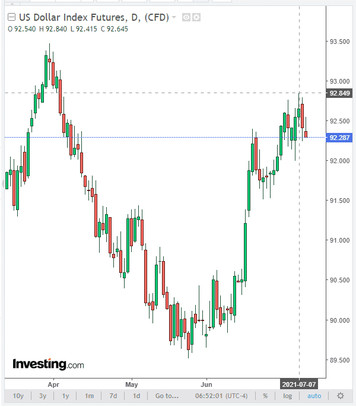The euro reacted positively to yesterday's decision by the ECB to reassess its monetary policy strategy. The euro strengthened significantly in the foreign exchange market and against the dollar on Thursday. Among the major currency pairs, the dollar weakened yesterday only against the yen, franc and euro.
If yesterday's strengthening of the yen and franc can be attributed to growing concerns about the continued spread of the coronavirus in the world, which now has a new delta strain, then the euro's growth on Thursday was largely due to this decision of the ECB.
On Thursday, EUR / USD jumped 0.6% (78 pips) to an intraday high of 1.1868, but then declined to end yesterday's trading at 1.1844.
On Thursday, the ECB adopted a symmetric inflation target of 2.0% over the medium term, thus softening policy, abandoning its previous target of just below 2.0%.
Economists believe that this does not change their forecast of the start of policy tightening later this year. Economists expect GDP growth and inflation to be higher than the ECB forecasts in late 2021 and 2022, setting the stage for the ECB likely to continue phasing out asset purchases from April 2022 after reducing PEPP bond purchases from September or December 2021. In their opinion, these purchases will be completed in September 2023 before the first rate hike by the ECB in December 2023.
Meanwhile, data released on Tuesday by the Institute for Supply Management (ISM) for the US services sector was weaker than economists' forecasts, signaling a possible slowdown in economic growth. Weaker-than-expected macro data slightly eased concerns about an earlier tightening of monetary policy.
Statistics released on Wednesday showed that the number of vacancies in the United States in May remained unchanged at 9.2 million, while the figure for April was revised from 9.3 million to 9.2 million.
And data from the American labor market published on Thursday indicated that last week the number of initial applications for unemployment benefits increased to 373 thousand, which is higher than analysts' forecast of 350 thousand. The previous figure was adjusted upward from 364 thousand to 371 thousand.
The minutes of the June Fed meeting released on Wednesday showed that central bank officials were discussing the procedure and timing for winding down measures to support the economy. However, they still spoke in favor of maintaining a wait-and-see attitude. The Fed will not rush to tighten monetary policy, relying on inflation alone, and only with the aggregate dynamics of indicators (inflation growth and maximum recovery of the labor market) can the central bank begin to change the parameters of monetary policy.
These events and news were enough for the dollar to resume its decline. Today, the DXY dollar index is declining for the second day in a row, risking ending the week in negative territory. DXY futures are traded near 92.28 as of this writing, 56 pips lower within the weekly and 3-month highs of 92.84.

Meanwhile, in our opinion, one should not expect a strong weakening of the dollar either. First, fears about the imminent recovery of the global economy are growing in the market amid an increase in the number of people infected with the new strain of COVID-19 "delta", and investors continue to redirect their assets to the protective US dollar. Secondly, the dollar may rise, since the Fed will nevertheless wind down stimulus before the ECB and the Bank of Japan.
And in the medium term, the market will continue to be dominated by multidirectional volatility, which increases during the publication of important macro data, mainly from the US and Europe.
One way or another, the main pair of the currency market EUR / USD has broken through the key long-term support level of 1.1930 and is traded within the newly formed descending channel on the daily chart (see Technical Analysis and Trading Recommendations).
And from the news for today, which may increase volatility in the market and in the EUR / USD pair, investors will pay attention to the minutes from the June meeting of the ECB with an overview of changes in financial, economic and monetary policy (its publication is scheduled for 11:30 GMT) and the publication (at 16:00 GMT) of the Fed's monetary policy report. In this regular semi-annual report to Congress, the Fed will provide information on the implementation of monetary policy, with comments on the current situation in the economy and its future prospects.





